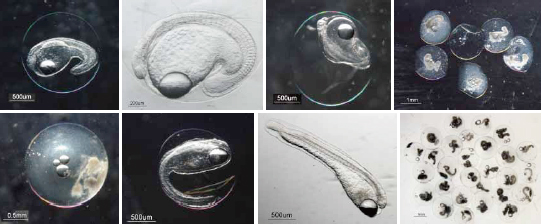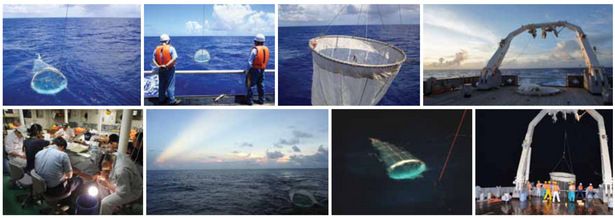Rapid Progress in Spawning Ecology Research on Freshwater eels
7.10, 2011
Katsumi Tsukamoto (Atmosphere and Ocean Research Institute of the University of Tokyo)

The R/V Hakuho Maru (JAMSTEC) has made a research cruise to the spawning area of the Japanese eel (Cruise KH-11-6), directed by Prof. Katsumi Tsukamoto of the Atmosphere and Ocean Research Institute of the University of Tokyo in June-July 2011, which has found wild Japanese eel eggs, by successfully collecting about 150 eggs.
Photographs of various stages of eggs of the Japanese eel, Anguilla japonica, that were collected near the salinity front along the southern end of the West Mariana Ridge Seamount chain in June of 2011.
The eggs were found exactly at the crossing point of the salinity front and the West Mariana Ridge (a seamount chain), which was expected based on the collection of a smaller number of eggs during the 2009 cruise. By back-calculating the developmental stage of eggs at the collection site, the eels appear to spawn every night consecutively for 2-4 days before new moon, and the depth of collection of eggs shows that spawning occurs below depths of about 150 m. This rapid progress in being able to study the spawning ecology of this important food fish under natural conditions can help aquaculture efforts to produce domesticated eels, which will help to protect wild eels from overharvest. Formalin-preserved eggs have also now been obtained, so people can see the eggs of this very important fish in Japanese food culture for the first time. This year marks the 20th anniversary of the discovery of the Japanese eel spawning area by a cruise of the research vessel Hakuho Maru, which has been an essential part of research on the spawning area of this interesting and mysterious fish.
Overview of the Scientific Findings of the Cruise
● Using the information gained in previous Hakuho Maru cruises, it was possible to precisely predict the exact area where eels would be spawning along the West Mariana Ridge, just to the south of a distinct salinity front, using only geographic and oceanographic information. By precisely targeting an exactly predicted location, eggs were collected on the 4th deployment of the ORI-Big Fish net of the cruise, 3 days before new moon.
● More than 130 eggs were collected, which is much more than in 2009, when the first ever freshwater eel eggs in the world were collected. This will provide valuable new information about the number of female and spawners that had participated in the spawning aggregation using DNA sequence parentage analyses, and over how many nights spawning had occurred in this one location.
● The determination of the environmental conditions of the spawning sites of the Japanese eel will help aquaculuturists to know what kind of factors may be important for using in the artificial production of eggs and larvae.
● It was possible to have the first clear validation that spawning occurs below the shallow, warm, surface layer at depths below 150 m, by determining the depth stratification of naturally spawned freshwater eel eggs for the first time ever. Because newly hatched preleptocephali could show a phototaxis response to swim deeper and away from sunlight, the collection of eggs in a narrow layer deeper than 150 m, has for the first time confirmed that spawning occurs below the thermocline of the ocean.
● The important role of oceanographic features such as the salinity front in determining the latitude of spawning along the ridge was validated by collecting eggs for the second time, thus we could determine an exact spawning site in relation to the structure of the seamount chain and oceanographic structure.
● Collection of preleptocephali after the eggs hatched has provided valuable information about the dispersion of larvae after spawning and the possible locations of multiple spawning events.

Scenes from the research cruise showing the ORI-Big Fish net used to catch Japanese eel eggs and larvae, and sorting the plankton onboard Hakuho Maru.
The R/V Hakuho Maru
● This is the 22nd year of operation of the research vessel (R/V) Hakuho Maru (100 m in length, 3991 tons, constructed by Mitsubishi Heavy Industries, Japan, 1989), which is a unique and valuable research vessel that is undoubtedly one of the best oceanographic ships in the world.
● During its more than 2 decades of service to the oceanographic community of Japan and the world, it has traveled around the Earth and to Antarctica several times, on cruises that have included scientists from many countries in all parts of the world.
● The highly professional captain and crew of Hakuho Maru provide continuous 24 hr comprehensive support for the scientists and their research efforts.
● This was the ship that enabled the spawning area of the Japanese eel to be discovered in 1991, preleptocephali to be collected for the first time in 2005, the first eggs in 2009, and now a much larger catch of eggs in 2011, making it an integral part of the history of research on freshwater eels. It has also surveyed the spawning areas of other freshwater eels in the Indian Ocean, South Pacific, and Indonesian Seas.
● Its large laboratories, comfortable, yet simple atmosphere, in combination with its graceful design in comparison with other research vessels, distinguish this ship from all others.

Photographs of the R/V Hakuho Maru of JAMSTEC and the Atmosphere and Ocean Research Institute of the University of Tokyo in the Japanese eel spawning area.
![]()



